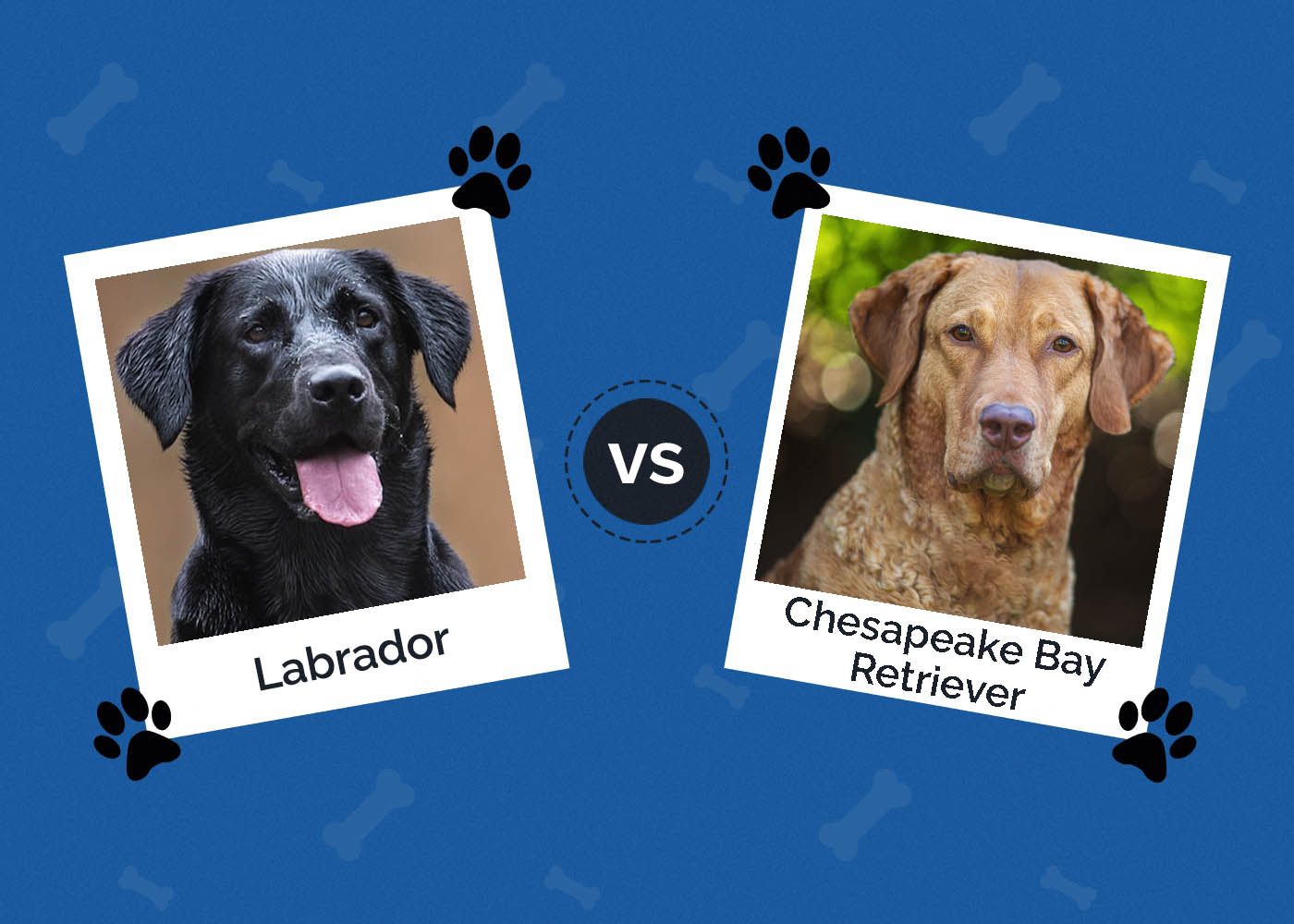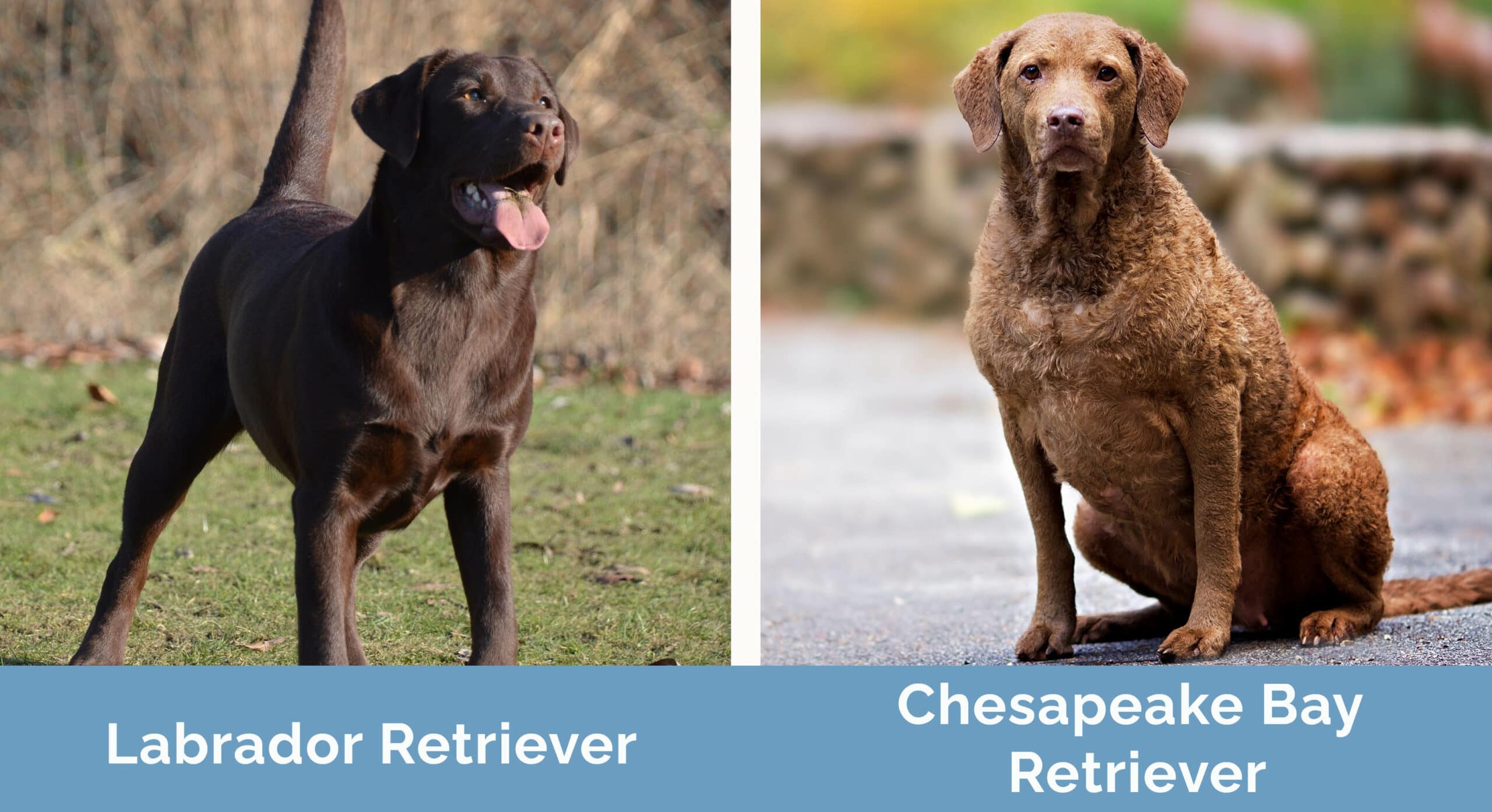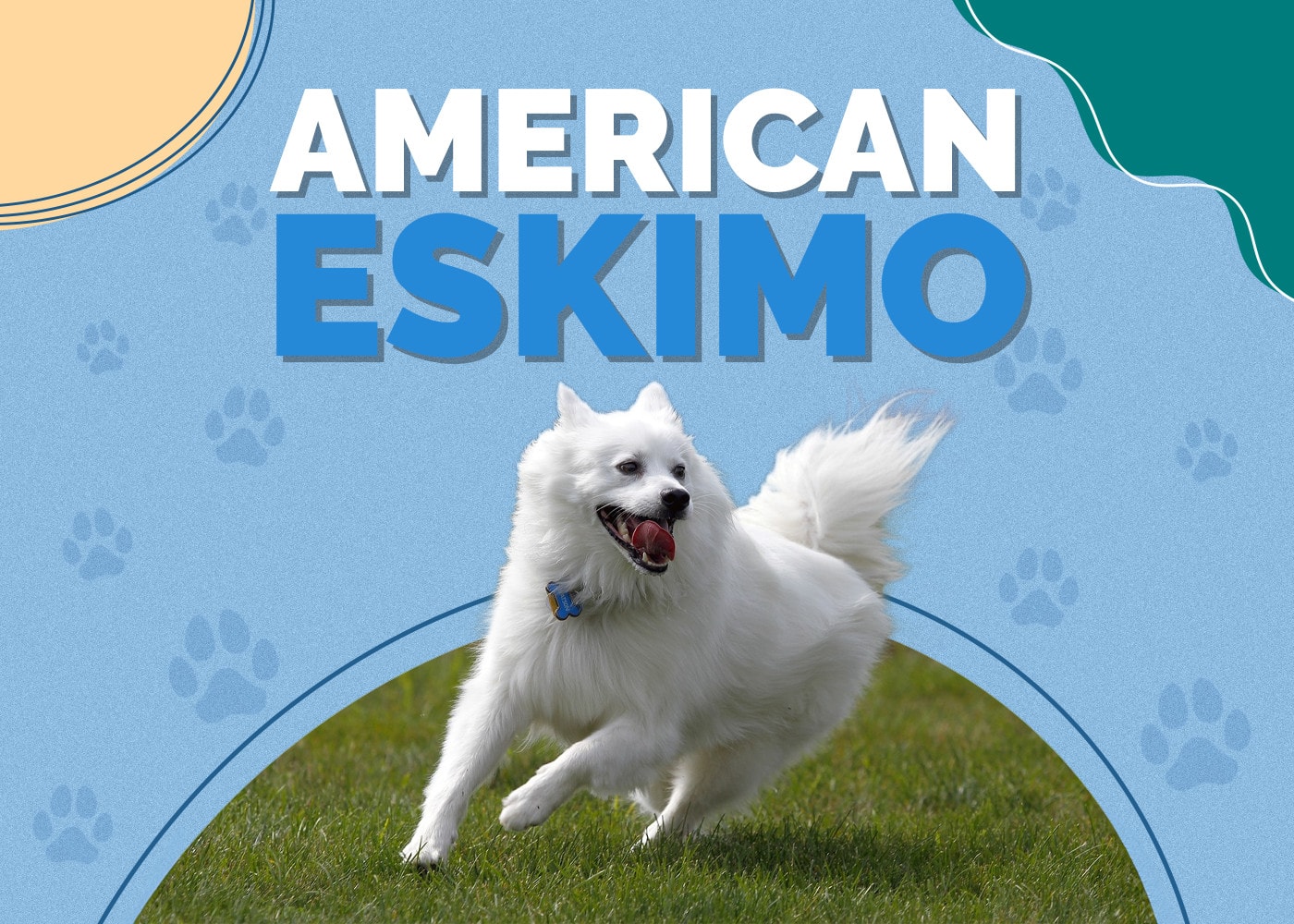Labrador vs Chesapeake Bay Retriever: What’s the Difference?

Updated on

The Chesapeake Bay Retriever and the Lab are very similar pooches in more ways than one. Their looks are subtly different, and their personalities are often miles apart.
The Lab is America’s favorite dog breed, and the Chesapeake Bay Retriever is relatively unknown in some parts of America. But that doesn’t mean that the Lab makes the better family pet! The Lab can be taken on by first-time dog owners, and the Chesapeake is a much more dominant dog that needs an experienced dog owner.
So, whether you’re here because you simply want to give yourself a doggy education or you have whittled your next family pooch down to these two breeds, you’ve come to the right place. This breed comparison guide is a must-read for anyone trying to decide between the Chesapeake Bay and the Lab. Because it only takes one difference to make them the better pooch for you and your family.
Let’s jump straight into the doggy details and retrieve all the information you need to find out which breed is right for you.
 Visual Differences
Visual Differences

A Quick Overview – Lab vs Chesapeake Bay Retriever
- Average Height (adult): 21½ – 24½ inches
- Average Weight (adult): 55 – 80 pounds
- Lifespan: 10 – 12 years
- Exercise: 1+ hours a day
- Grooming Needs: Moderate
- Family-friendly: Yes
- Dog-friendly: Often
- Trainability: Intelligent, loyal, eager to please
- Average Height (adult): 21 – 26 inches
- Average Weight (adult): 55 – 80 pounds
- Lifespan: 10 – 13 years
- Exercise: 2+ hours a day
- Grooming Needs: Moderate
- Family-friendly: Yes
- Dog-friendly: Often
- Trainability: Intelligent but stubborn
Labrador Retriever Overview

The Labrador Retriever is from Newfoundland (not Labrador, as you might expect). Like the Chesapeake, this guy is a water doggo who collected the hunt of his master in the water. He was also assigned a boat, and it was his job to retrieve the fish that came from the trawl. His thick otter-like tail helped him to steer his way in the waters.
He proved himself to be hardworking and loyal to a tee, and the fishermen soon recognized his soft and sweet side in the family home. He is still used as a fisherman’s canine colleague, but he is now more traditionally found lazing in family homes, lapping up all the attention.
He, too, has found employment outside of the fisherman arena and is commonly used as an assistance and therapy dog. Dependable and friendly, there is not much that the Labrador takes offense at.
The Labrador is the most popular family dog in America and has been for almost three decades now. The average price of a Lab puppy from a reputable breeder starts at around $1,000. Being the most popular dog breed, there is no shortage of reputable dog breeders. But equally, there are a lot of unscrupulous breeders, so be sure to do your homework.
Personality
The Lab is known for his happy-go-lucky personality. He is a laidback dog and is happy to join in with whatever his master is doing. Be that exercising, playing games, working hard in the garden, or Netflix and chillin’ on the sofa. Whatever your hobbies are, you can be sure to find a sidekick with the Lab.
But be warned, he hates to be left alone, and he can be a very needy dog. He is likely to suffer from separation anxiety, so he isn’t an ideal match for those who work long hours or who are rarely at home.
He is super friendly and will interact and play with anyone. Including the local delivery guy and wannabe intruders! This is great if you are a sociable family who is forever hosting parties because the Lab will be a fantastic host and source of entertainment. But not so great if you are seeking a watchdog or guard dog.
Training
The Lab is one of the easiest dogs to train and makes a fantastic option for first-time dog owners. This is why he is frequently chosen as an assistance dog and therapy dog. But don’t mistake this as an easy get out. He still needs to be shown the doggy ropes. Otherwise, he will turn into an unruly dog.
He needs to be socialized well so that he knows how to interact nicely with other dogs, animals, and unfamiliar humans. This will mean that he grows into the dog that we all know and love. It will also build his confidence.
When it comes to obedience training, he is likely to pick this up much easier than the Chesapeake. Mainly because he is much more eager to please. His motivation to learn new tricks will be food because the Lab is a forever hungry hippo.

Health & Care
The Labrador Retriever is a relatively healthy dog that enjoys a lifespan of 10 to 12 years. The common Labrador health conditions to look out for are hip and elbow dysplasia, various health concerns, and EIC as outlined above.
The Labrador Retriever will also consume between two and three cups of food a day. Again, this might change depending on his size, age, and activity levels. The Labrador is also prone to obesity, so you need to be extra careful about his food consumption. Never overfeed him, and monitor his daily treat allowance.
The Lab will hoover his food down quicker than you can say his name. You need to be wary of a condition called bloat. This is where his stomach twists and it usually occurs when eating. We would suggest feeding him in a slow feed bowl to slow him down at mealtime.
The Labrador has a thick and dense coat, but his fur is straight and much less oily than the Chesapeake’s coat. He will need brushing twice a week or so throughout the year and more frequently during the shedding seasons. He will need bathing once every 12 weeks or so.
- Suitable For: The Labrador is an easy-going dog who loves to hang with his family. So as long as his family has got the time to keep him company for most of the day, he will fit in well. He is suited to first-time dog owners thanks to his loyalty and eagerness to please. Those seeking a social butterfly will find a great pet in the Labrador.
Chesapeake Bay Retriever Overview

The Chesapeake Bay Retriever originates from the 200-mile long bay of Chesapeake. The owners of the duck clubs that lined the shore set out to create the perfect duck hunting canine, and so they made the Chesapeake Bay Retriever.
It comes as a surprise to many that the Chesapeake Bay Retriever is not related to the Labrador. He is a mixture of other dog breeds, including Newfoundlands, Irish Water Spaniels, and other unknown breeds. He has webbed feet that he inherited from the Newfoundland breed, which helps him work on the wet and sandy bays.
His hardworking ethic is limitless, and he has been known to collect up to 300 ducks in one day. His loyalty and scenting ability are second to none, making him ideal for therapy roles and tracking work with K9 handlers in law enforcement fields.
The average price of a Chesapeake Bay Retriever puppy starts from around $1,000. This can be more or less dependant on where you live and the demand in your local area. If you are seeking a puppy from an award-winning duck hunter lineage, you can expect to pay a lot more than this.
Personality
The Chesapeake Bay Retriever is a hardworking dog who is full of energy. These guys are not suited to the average family. He needs to be worked as a duck hunter, or his owners need to be able to exercise him between one and two hours every day. On top of that, he needs plenty of interactive playtime in between to keep him occupied throughout the day.
When he has been exercised adequately, he is happy to settle down for the evening to enjoy a cuddle with his family. Chesapeakes are not overly affectionate or needy, which suits many dog owners. He is happy to cuddle, but equally glad to lay in front of the fire, keeping himself company.
The Chesapeake Bay Retriever is aloof with strangers, and he can be quite a protective dog. If you are seeking a guard dog, he is the better option of the two for sure. He also isn’t that fussed about playing with other dogs either. Instead, he would much rather work the water with his master, and he is the much more serious pup.
Training
The Chesapeake Bay Retriever is a hardworking and intelligent dog, but he is also stubborn and independent. He has a dominant personality, so his owners must start obedience training as soon as they bring him home. He needs discipline in his life, otherwise, he will challenge his owners as the pack leader.
Just like all dogs, he needs to be socialized as a pup to grow into a pleasant pooch with good manners. But because of his potentially protective nature and dominant character, he will grow into an obnoxious dog if he isn’t socialized adequately. And one who is too much to handle for most families. This is why he should only be homed with a family with previous dog-owning experience. First-time dog owners might find this guy too intense for a first dog.

Health & Care
The Chesapeake Bay Retriever is a generally healthy dog who enjoys a reasonably long lifespan of 10 to 13 years. The main concerns to watch out for in the Chesapeake are hip and elbow dysplasia, various eye concerns, and degenerative myelopathy.
You also should be aware of a condition called exercise-induced collapse (EIC), which is what it says on the tin. During exercise, he can collapse. If you notice during his exercise sessions that he is struggling to breathe or he is lame in any way, he could be suffering from an episode of EIC.
The Chesapeake Bay Retriever will consume between two and three cups of food a day. This is dependant on his age, size, and energy levels. If he is a working Chesapeake, he will probably need to eat more than this.
The Chesapeake has a thick and dense coat that is wavy. This is often the main tell-tale sign that he is a Chesapeake and not a Lab. His coat is also oily too, much like a duck’s feathers. This helps to keep his jacket waterproof when working in the freezing waters.
He will need brushing every day to keep his coat tangle and dirt free. He will only need bathing once every three to four months. Otherwise, you risk damaging his natural oily protection barrier.
- Suitable For: As an intensely hardworking dog, and one who is dominant in nature, he is ideal for families who have previous dog experience and can exercise him well. Those with larger homes and access to a private yard will be required.
 Labrador vs Chesapeake Bay Retriever – Conclusion
Labrador vs Chesapeake Bay Retriever – Conclusion
There are many similarities between the Labrador and the Chesapeake Bay Retriever. They are both traditional working dogs who love the water and make ideal playmates for lakeside living. They look similar in appearance, so if you are a fan of stocky but sporty looking doggos, both of these guys will appeal to you. If you like curly locks, though, the Chesapeake is the obvious choice.
Their personality is where they really differ. When comparing the Labrador vs Chesapeake Bay Retriever, the Chesapeake is the more serious and hardworking of the two, and he needs to be placed with an active family. Otherwise, he will become very unhappy very quickly. On the other hand, the Labrador also needs a busy family, but he is much more likely to chill out and watch a film with you.
The Chesapeake Bay Retriever is an independent dog who sometimes thinks he doesn’t need a master; he is his own boss. For this reason, he is only suitable for an owner who has previous dog-owning experience and who can be firm but fair. The Labrador is much easier going and can be taken on by a first-time dog owner.
Welcoming a dog into your life is one of the biggest decisions you’ll ever make, so you must research both the Labrador and Chesapeake Bay Retriever. Both of these guys need a different type of family. Just because the Labrador is America’s favorite doggo doesn’t mean that he is the best family dog. It all depends on you and your lifestyle, and what you want from canine companionship.
- You May Also Like: How Much Does a Chesapeake Bay Retriever Cost?
Featured Image Credit to: (L) Ben Hanson, Unsplash | (R) Kerrie T, Shutterstock
 Visual Differences
Visual Differences

 Labrador vs Chesapeake Bay Retriever – Conclusion
Labrador vs Chesapeake Bay Retriever – Conclusion








